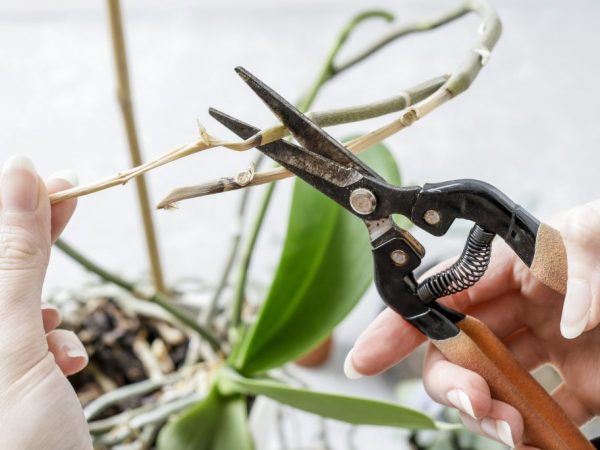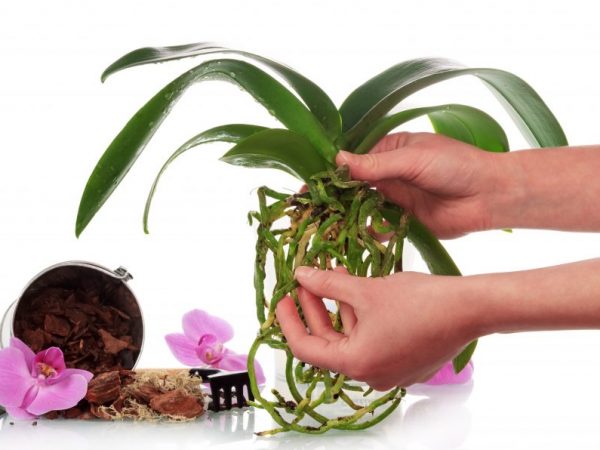How to plant an orchid correctly
Orchid is a unique ornamental plant. It decorates with flowering both the home garden and the indoor interior. It is real to propagate this plant at home, for this there are rules for how the correct transplant of an orchid baby is made.

How to plant an orchid correctly
Reproduction methods
The plant has several ways to reproduce:
- seeds;
- dividing the trunk of the mother plant into parts;
- sprouts (side shoots).
Phalaenopsis orchid reproduces only vegetatively. You can plant flowers using sprouts. But at the same time, if lateral processes appeared on the flower from the root, and not from the stem, these are deviations from the norm. It indicates that mistakes were made in the care of the plant. If root jigging is planned, but there are no children, they are awakened artificially.
When to transplant a sprout
In phalaenopsis, shoots are formed on the peduncle. In some orchid species, they can form in the leaf sinus of the main trunk or at the base of the root collar. Initially, it grows, but does not have a root system. It is formed as the shoot develops. It is better to transplant an orchid baby at home when roots (more than 5 cm in length) and 5 fully formed leaves have appeared on the shoot. The roots and leaves indicate the readiness of the sprout to independently obtain nutrients from the soil.
The florist must carefully monitor the process. If shoots have appeared on the peduncle, but the plant is only blooming or the flowering period reaches its final stage, then the baby cannot be planted. The flower needs a rest of 1.5-2 months. It is allowed to divide and plant shoots until the moment when they begin to outgrow. On average, full development takes 5-6 months. If a person does not comply with the time frame, then it will be more difficult to plant a young baby from an orchid, since one careless movement will damage the mother.
How to separate correctly
In order to properly separate the orchid baby and transplant it into a new container, the florist must prepare a workplace. To transplant a young plant, you will need the following tools and materials:
- Rubber gloves for hand protection.
- Capacity where to plant the phalaenopsis orchid baby. It is good if this is a new plastic pot with a diameter of 6-10 cm with transparent walls and drainage holes at the bottom. This allows excess water to be removed.
- Sharp tool. For this purpose, a knife, pruner, scissors are suitable. It must be not only well-sharpened, but also disinfected. To reduce the risk of infection with pathogenic microflora of the mother while trying to separate the baby from the home orchid.
- Sphagnum moss and new soil with a fine fraction.
- Cinnamon or activated charcoal to sprinkle on the cut.
- Alcohol or antiseptic. They are used to wipe work tools before and after the end of the process.

The transplant knife must be well sharpened and disinfected
The procedure for separating from the mother stem is performed step by step:
- First, you should separate the baby from the orchid. For this, a miniature plant is cut along with a part of the peduncle on which it was formed. The length of the maternal peduncle is about 1 cm from the base of the sprout. In some cases, it is allowed to capture more than 1 cm. This is how the root separation from the leaf axils occurs.
- The sections formed on the peduncle, branch, leaf, as well as on the separated planting material are dried for 20-25 minutes. After they are treated with cinnamon or crushed activated carbon.
To plant a young orchid baby, they track the moment when the baby appeared on the stem, put down roots and has a healthy appearance. Separation of the sprout is started only after that.
What soil is suitable for an orchid
The separated process is transplanted into a new container. They fall asleep in a new pot in a previously prepared soil. It is easy to get it from a flower shop or make it at home. This requires pine bark. It is crushed into pieces no more than 1 cm in diameter. The bark must not be peat or pine dust.
Another version of the soil into which it is allowed to transplant a new orchid baby is moss. Based on the recommendations, it is better to use it as a substrate. This is due to the fact that the bark is characterized by good moisture holding capacity and air permeability.
In rooms with a dry microclimate, sphagnum moss is an indispensable assistant, making the soil moisture-absorbing. If the climate is temperate or too humid, moss should be avoided. To plant a baby of a decorative orchid in an overly wet soil is fraught with consequences. After a while, the first signs of abnormal development will appear: wilting of the leaf plate, loss of color, etc.
How does the transplant take place
After the sprout has grown and the maternal part of the plant has given it everything it needs for independent functioning, an attempt is made to transplant the resulting orchid baby.
For this:
- Take a transparent pot (if there is none, a container from under a cotton swab is suitable). Holes are made at the bottom so that excess water does not accumulate.
- It is important to plant the sprout strictly in the middle, so that its root collar is flush with the edges of the container. The roots are carefully placed on the ground surface.
- Then, gently holding the young phalaenopsis, the pot is filled with a substrate.
- The soil is carefully tamped so as not to add the substrate.

Orchid baby transplant rules
Post-transplant care
If everything was done correctly, the grower managed to plant a new orchid baby. The next stage is caring for a young plant. Watering a planted flower is carried out only for 2-4 days. This time is enough for the roots to take root in the new soil.
As soon as the orchid has taken root, began to grow and bloom, fertilizers are applied. This is done in dosage, during watering. If the seedling does not develop well, a cozy atmosphere is created for such a flower, observing the rules for setting the temperature, lighting, and watering.
Conclusion
Transplanting a home orchid baby and growing a new full-fledged flower is not an easy task. The process involves careful adherence to the rules, but the result is worth it to make every effort for this matter.


